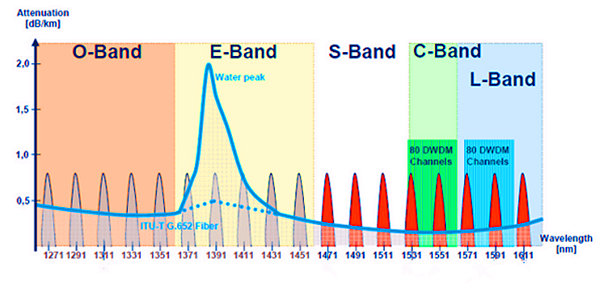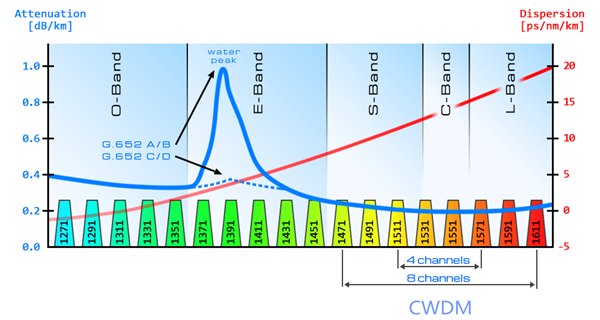As we all know, 40GBASE-SR4 QSFP+ transceivers usually use a parallel multimode fiber (MMF) link to achieve 40G. It offers 4 independent transmit and receive channels, each capable of 10G operation for an aggregate data rate of 40G over 100 meters of OM3 MMF or 150 meters of OM4 MMF. However, for 40GBASE-LR4 QSFP+ transceivers, there are two kinds of links. One is coarse wavelength division multiplexing (CWDM) and the other is parallel single-mode fiber (PSM). What’s the difference between them? In this article, I will show their working principles to you respectively.
40GBASE-LR4 CWDM QSFP+ Transceiver
 The 40GBASE-LR4 CWDM QSFP+ transceiver, such as QSFP-40GE-LR4, is compliant to 40GBASE-LR4 of the IEEE P802.3ba standard. It contains a duplex LC connector for the optical interface. The maximum transmission distance of this transceiver is 10km. To minimize the optical dispersion in the long-haul system, single-mode fiber (SMF) has to be used. This transceiver converts 4 inputs channels of 10G electrical data to 4 CWDM optical signals by a driven 4-wavelength distributed feedback (DFB) laser array, and then multiplexes them into a single channel for 40G optical transmission, propagating out of the transmitter module from the SMF. Reversely, the receiver module accepts the 40G CWDM optical signals input, and demultiplexes it into 4 individual 10G channels with different wavelengths. The central wavelengths of the 4 CWDM channels are 1271, 1291, 1311 and 1331 nm as members of the CWDM wavelength grid defined in ITU-T G694.2. Each wavelength channel is collected by a discrete photo diode and output as electric data after being amplified by a transimpedance amplifier (TIA).
The 40GBASE-LR4 CWDM QSFP+ transceiver, such as QSFP-40GE-LR4, is compliant to 40GBASE-LR4 of the IEEE P802.3ba standard. It contains a duplex LC connector for the optical interface. The maximum transmission distance of this transceiver is 10km. To minimize the optical dispersion in the long-haul system, single-mode fiber (SMF) has to be used. This transceiver converts 4 inputs channels of 10G electrical data to 4 CWDM optical signals by a driven 4-wavelength distributed feedback (DFB) laser array, and then multiplexes them into a single channel for 40G optical transmission, propagating out of the transmitter module from the SMF. Reversely, the receiver module accepts the 40G CWDM optical signals input, and demultiplexes it into 4 individual 10G channels with different wavelengths. The central wavelengths of the 4 CWDM channels are 1271, 1291, 1311 and 1331 nm as members of the CWDM wavelength grid defined in ITU-T G694.2. Each wavelength channel is collected by a discrete photo diode and output as electric data after being amplified by a transimpedance amplifier (TIA).

40GBASE-LR4 PSM QSFP+ Transceiver
 Unlike CWDM QSFP+ transceiver which uses a LC connector, PSM QSFP+ is a parallel single-mode optical transceiver with an MTP/MPO fiber ribbon connector. It also offers 4 independent transmit and receive channels, each capable of 10G operation for an aggregate data rate of 40G on 10km of single-mode fiber. Proper alignment is ensured by the guide pins inside the receptacle. The cable usually cannot be twisted for proper channel to channel alignment. In terms of a PSM QSFP+, the transmitter module accepts electrical input signals compatible with common mode logic (CML) levels. All input data signals are differential and internally terminated. The receiver module converts parallel optical input signals via a photo detector array into parallel electrical output signals. The receiver module outputs electrical signals are also voltage compatible with CML levels. All data signals are differential and support a data rates up to 10.3G per channel.
Unlike CWDM QSFP+ transceiver which uses a LC connector, PSM QSFP+ is a parallel single-mode optical transceiver with an MTP/MPO fiber ribbon connector. It also offers 4 independent transmit and receive channels, each capable of 10G operation for an aggregate data rate of 40G on 10km of single-mode fiber. Proper alignment is ensured by the guide pins inside the receptacle. The cable usually cannot be twisted for proper channel to channel alignment. In terms of a PSM QSFP+, the transmitter module accepts electrical input signals compatible with common mode logic (CML) levels. All input data signals are differential and internally terminated. The receiver module converts parallel optical input signals via a photo detector array into parallel electrical output signals. The receiver module outputs electrical signals are also voltage compatible with CML levels. All data signals are differential and support a data rates up to 10.3G per channel.

What’s the Difference?
From an optical transceiver module structure viewpoint, PSM seems more cost effective because it uses a single uncooled CW laser which splits its output power into four integrated silicon modulators. Besides, its array-fiber coupling to an MTP connector is relatively simple. However, from an infrastructure viewpoint, PSM would be more expensive when the link distance is long, mainly due to the fact that PSM uses 8 optical single-mode fibers while CWDM uses only 2 optical single-mode fibers. A summary table comparing the key differences between CWDM and PSM is shown below:
| Name | CWDM | PSM |
| Optical TX | 4 uncooled 1300nm CWDM directly-modulated laserswavelength spacing 20 nm | 4 integrated silicon photonic modulators and one CW laseruncooled 1300nm DFB laser |
| 4-wavelength CWDM multiplexer and demultiplexer | Needed | No need |
| Connector | Duplex LC connector | MTP/MPO fiber ribbon connector |
| Cable | Via 2 optical single-mode fibers | Via 8 optical single-mode fibers |
In addition, the caveat is that the entire optical fiber infrastructure within a data center, including patch panels, has to be changed to accommodate MTP connectors and ribbon cables, which are more expensive than conventional LC connectors and regular SMF cables. What’s more, cleaning MTP connectors is not a straightforward task. Therefore, CWDM is a more profitable and popular 40G QSFP link.
Conclusion
For 40GBASE-LR4 QSFP+ transceivers, either CWDM link or PSM link, the maximum transmission distance is both 10km. 40GBASE-LR4 CWDM QSFP+ transceivers use a duplex LC connector via 2 optical single-mode fibers to achieve 40G. However, 40GBASE-LR4 PSM QSFP+ transceivers use an MTP/MPO fiber ribbon connector via 8 optical single-mode fibers to reach 40G. Therefore, CWDM QSFP+ enables data center operators to upgrade to 40G connectivity without making any changes to the previous 10G fiber cable plant, which is more cost-effective and widely used by people. Fiberstore provides wide brand compatible 40G CWDM QSFP+ transceivers, such as Juniper compatible JNP-QSFP-40G-LR4 and HP compatible JG661A. In Fiberstore, each fiber optic transceiver has been tested to ensure its compatibility and interoperability. Please rest assured to buy. For more information or quotation, please contact us via sales@fs.com.
Related Article: 40G Transceiver Module: QSFP+ Module And CFP Module





